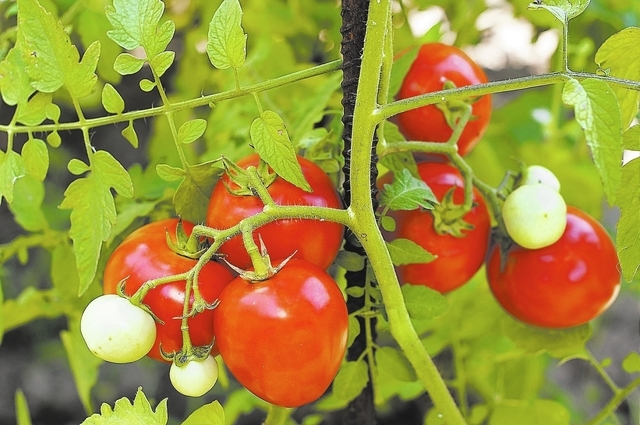Rotate crops to help reduce chance of disease
Q: I grow tomatoes in boxes I have built. I know one is supposed to plant tomatoes in a different place every year and I don’t want to just throw away the dirt in these boxes. I don’t have many places to put this dirt so my question is, “Can I put this dirt in my compost bins?” I have two cement block bins. What, if anything, can I do to that dirt to use it in the same boxes next year at planting time? It’s expensive to buy new dirt and I am poor.
A: Being poor is a good reason to grow your own food. I wish more poor people did it. If you want to grow tomatoes in the same soil year after year, it is probable you will have increased problems down the road if you don’t do something about it. In our climate, problems are mostly because of accumulation of soil diseases.
Growing different crops in this same soil helps reduce this problem and is called crop rotation, an important practice in organic vegetable production. Growing crops from different families in the same soil helps interfere with this buildup of disease problems.
In the off season, when your tomatoes are not in production, you could put some cold-weather vegetables in that soil. These can be radishes, beans, beets, broccoli, lettuce, spinach, endive and the like. This will help reduce the disease cycle but, unfortunately, soils need a bit longer rest from the same crop than just one season.
You can solarize this soil by using the sun to help reduce some of the disease potential. If these are small boxes, moisten and put the soil in a clear plastic bag for a few days in full sun and let it bake. If you can get the temperature of the soil in the plastic bag to more than 165 F for at least 30 minutes, you will substantially reduce disease problems.
While you’re at it and the soil is removed, you should surface sterilize the sides of boxes as well. You can sanitize them using a 10 percent bleach solution or other sanitizer and let them air dry before filling them again.
If the boxes are too large to do this, after your tomatoes are finished for the season, spade the soil deeply with a spading fork and turn it over. Make sure it is well aerated and as fluffy as possible.
Do not turn the remaining tomato plants over in the soil and let them decompose. Remove and compost them, solarize them or discard them if you can’t compost them.
Moisten the soil lightly and cover it with clear plastic making sure the edges of the plastic are buried and the plastic is sealed around the edges. Let it bake in the sun for several days.
Regardless of whether you took the soil out of the box or not, amend it with compost and a starter fertilizer before planting
Q: My nectarine fruits have this corky appearance on the outside on their skins. They do this every year. I don’t apply any pesticides. I sent you a picture. Why does this occur?
A: I will post your picture on my blog as well as some others that are similar that are common to nectarine.
Nectarine is a hairless peach fruit. Not having hair on the skin allows a lot of things to damage the fruit. Hair provides a lot of protection and slows down water loss from the fruit as well. When the fruit skin is damaged by blowing sand, disease and insects, the skin reacts by growing a corky surface, which we could relate to as “scabby.”
Instead of scabby, we call it russeting. A plant we are probably most familiar with, the Russet Burbank potato, has a naturally rough, dark brown, corky skin.
Russeting is because of damage to the skin. If this type of damage continues, the entire fruit could be covered with this corky surface. From your picture, it appears that it started and then stopped for some reason since it only covers a small portion of the fruit. So, we are looking for something that happened to the fruit when it was pretty young.
The usual reason for this in Southern Nevada would be thrips damage. Thrips are tiny insects that cause damage to soft plant tissue early in the spring. If they are left uncontrolled, this damage can cover the entire fruit or even cause the fruit to drop from the tree. I was a little confused, because the damage was only in a small area of the fruit and you did not use any pesticides to control them. With uncontrolled thrips you would have expected the damage to continue and cover the entire fruit.
I forwarded your picture to a friend at Dave Wilson Nursery in California and he confirmed the thrips damage. You should apply Spinosad insecticide, an organic pesticide, with a wetting agent so that the entire fruit is protected from thrips. You apply this immediately after flower petal fall in the spring; do three applications about a week apart.
A number of my readers also catch my responses and pictures on my online blog, Xtremehorticulture of the Desert. This allows me to post pictures of problems as well as pictures I have accumulated during the past 30 years.
Blogs primarily focus on one person’s contributions and don’t allow for much discussion to occur. For this reason, I started a horticulture discussion group on Yahoo. The Yahoo discussion group, Desert Horticulture, allows you to join the group and post questions or contribute to the answers to questions that are posted.
Please come and join us in these horticultural discussions. If you can’t find it, send me an email and I will help connect you.
Bob Morris is a horticulture expert living in Las Vegas and professor emeritus for the University of Nevada. Visit his blog at xtremehorticulture.blogspot.com.























